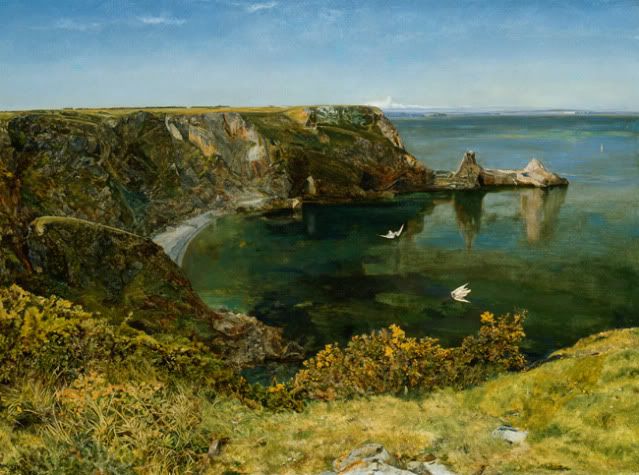Today I thought I'd share a video from Florence + The Machine. My husband actually made me sit down and watch the video because he noticed all the mythological and Pre-Raphaelite references! We first encountered Florence + The Machine while watching the Colbert Report, and our first reaction (other than noticing that she had a great voice), was that she looked like she'd fallen out of a Pre-Raphaelite painting. Apparently this is no coincidence, and you'll notice that most of her videos contain references to the Pre-Raphaelites, though the video for "Rabbit Heart" is one of the most overt. From the minute you see the water behind her you can tell this is going to end in a send-up of the Lady of Shalott!
For an even heavier dose of the Lady of Shalott, check out The Band Perry's "If I Die Young". My daughter actually discovered this one on Vevo the other day!
Someone from the band is clearly a big fan of the Pre-Raphaelites! Of course Lady of Shalott is the most obvious reference (the video actually closes with a shot of Tennyson's poem), but I thought the scene at :38 (with the mother at the window) was a little evocative of John Everett Millais' Mariana. It's a very well done video, and the song is beautiful as well.
Tuesday, July 26, 2011
Florence + The Machine, The Band Perry and the Lady of Shalott in Music Videos
Posted by
Margaret
at
4:09 PM
5
comments
![]()
![]()
Labels: millais, music, mythology, pre-raphaelites
Monday, November 22, 2010
Did the Pre-Raphaelites Suffer from "Blurred Vision?"
This morning I came across a less-than-enthused review of "The Pre-Raphaelite Lens" in the Washington Post. In the article, Andy Grundberg criticized what he termed the "blurred vision" of the Pre-Raphaelites. And while Grundberg retained some admiration for the work done by Pre-Raphaelite landscape artists, he condemned the Brotherhood with broad strokes, arguing that "its members claimed to be interested in realism and truth" but were "far more taken with notions of fiction and theatricality."
Grundberg was a photography critic for the New York Times for many years, so it's not surprising that he prefers the Pre-Raphaelites landscapes and photography to their paintings. But his criticism of the PRB is pretty standard. Many modern viewers can appreciate the work of artists like John William Inchbold (whose photograph-quality painting of Anstey's Cove is pictured here), and even Ford Maddox Brown, but remain perplexed by the romanticism of Dante Gabriel Rossetti and Sir Edward Coley Burne-Jones.
I was particularly struck by Grundberg's backhanded compliment that Julia Margaret Cameron and Henry Peach Robinson had "managed against odds to transcend their subjects' goofy origins in Arthurian legend." So now it's "goofy" to be inspired by myths and legend? Greek myth has inspired countless artists and is (quite rightly) not regarded as a "goofy" source of inspiration. Why should ancient British myths be seen differently?
Mythology is such a rich source of inspiration for artists, and it saddens me to see it dismissed off-hand. Many members of the PRB were actually very interested in a "modern" approach to art and design. They recognized that British art had become mired in convention and instead attempted to use the classics as a foundation to build from that would allow them break free from traditions that had become oppressive to artists. Even William Morris, whose passion for the middle ages is well-known, was not attempting to imitate medieval design, but to use it as a source of inspiration to create a better future.
Apparently, people today are confused that a a group that claimed to be visionary would lean so heavily on mythology and the classics for inspiration. Contemporary artists and (and their adoring critics) have the hubris to claim that they have re-invented the wheel, or are totally unencumbered by the influence of others from the past (the Young British Artists come to mind). And while this unfettered arrogance is intriguing, and can sometimes produce fascinating work, it also runs the risk of alienating the public with its hollow promise of unbridled innovation. A connection to the past and an understanding of our collective unconscious is not "goofy" - it's a fundamental part of the creative process.
Posted by
Margaret
at
4:08 PM
14
comments
![]()
![]()
Labels: Arthurian legend, edward burne-jones, medieval, mythology, pre-raphaelites, rossetti, william morris
Saturday, October 16, 2010
Camelot - New TV Series Starring Eva Green and Joseph Fiennes
I've been an undying fan of Arthurian legend for as long as I can remember. I wish I could say that my first encounter with the Knights of the Round Table was Malory's Morte D'Arthur, or even Howard Pyle (though both came very soon after!). No, it was actually Bing Crosby's 1949 version of A Connecticut Yankee in King Arthur's Court. I was about 7, and was completely captivated by the film. Looking back, I realize the the story was pretty silly, and a commercial failure of epic proportions. But as a kid, none of that mattered. I was hooked from the moment Bing woke up in Camelot - I loved the clothes, romance, adventure and the corny, stilted, olde-ish English (and, truth be told, I still like the movie!).
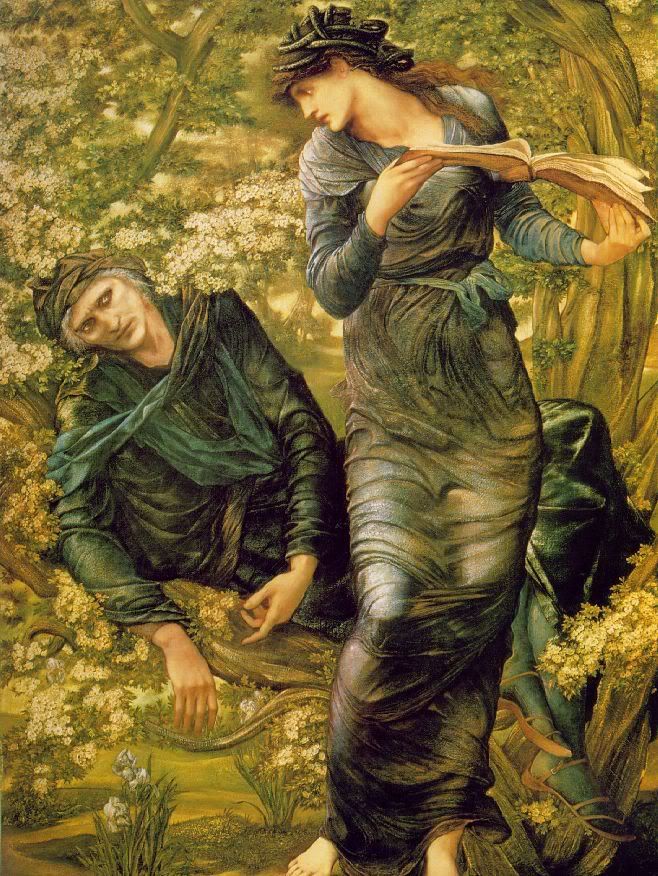
Even today, it seems I can't get enough of Arthurian legend on film. Good, bad or indifferent, I'm always willing to check out the latest Hollywood offering. So, imagine my delight at the announcement that Eva Green (Casino Royale) and Joseph Fiennes (Shakespeare in Love) will be starring as Morgana and Merlin in a new television series entitled Camelot. The series is set to premier in early 2011 and will be broadcast internationally by GK-TV, through the CBC in Canada and by Starz in the US.
The 10 part mini-series will be based on Malory's Morte D'Arthur, and is being shot at Ardmore Studios, where The Tudors was also filmed.
Will you be watching?
Image: Sir Edward Coley Burne-Jones, The Beguiling of Merlin, 1872-1877
Posted by
Margaret
at
12:03 PM
8
comments
![]()
![]()
Labels: edward burne-jones, mythology, news
Tuesday, September 2, 2008
Botticelli's The Birth of Venus
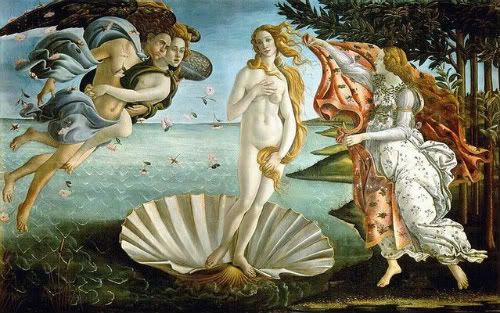
First of all, I would like to thank Stephen, from A World Away, for suggesting that I do a post or two on Botticelli! Sandro Botticelli's paintings are some of the most iconic and evocative works in Western art, and I'm actually quite surprised that this is the first time I've written about them! For the next few days, I will be focusing on the work of Botticelli and its relationship to the Pre-Raphaelite movement. I'll begin today by examining Botticelli's The Birth of Venus. It's one of those images that is so much a part of the Western psyche that it now truly deserves to be considered iconic, although this was not always the case, as we shall see.
There are actually a number of myths that explain Venus' origin, but Botticelli chose one of the earliest (and also the most violent and bloody) as the inspiration for his painting. According to Greek mythology, after Uranus was castrated by his son, Cronus, his severed genitals fell into the water and somehow fertilized it. Venus/Aphrodite later emerges from the water, having been conceived via the ocean's fertile waves. This rather far-flung story inspired Botticelli to create his most famous work, The Birth of Venus.
The painting itself was composed around 1482 for a member of the Medici family--Lorenzo di Pierfrancesco de' Medici--and was hung at Lorenzo's Villa di Castello. Interestingly, the painting was done in tempera on canvas, rather than wood (at the time Botticelli painted the Venus, it was common for artists to compose important works on wood, as it was considered more durable). Part of the reason that the painting might have been done on canvas was that it featured a decidedly pagan theme.
The work features a stylised, distinctively European Venus emerging from the water on a seashell (shells themselves were an erotic symbol for the Romans, probably because shellfish had long been viewed as aphrodisiacs. Casanova, another famous Italian, reportedly used to eat 50 of them every morning for breakfast). The shell is being blown towards the shore by the Zephyrs (a zephyr is a gentle wind, associated with spring). In the right foreground is the goddess Horae, the goddess of the seasons, who is preparing to cover Venus in a flowered cape. In this painting, Botticelli presents an image of Venus that is at once the embodiment of femininity and sensuality, who affects modesty at the same time. This paradox was what would later fascinate the Pre-Raphaelites, who were interested in creating a synthesis between the pagan and christian traditions.
Thursday I will be looking at the surprising connections between Botticelli and the Pre-Raphaelites.
Image courtesy wikimedia.
Source Consulted: Michael Levey. "Botticelli and Nineteenth-Century England." Journal of the Warburg and Courtauld Institutes, Vol. 23, No. 3/4 (Jul. - Dec., 1960), pp. 291-306.
Posted by
Margaret
at
6:30 AM
13
comments
![]()
![]()
Labels: mythology, pre-raphaelites
Thursday, June 26, 2008
Greek Vase from British Museum depicting Ulysses and the Sirens
In Greek mythology, the Sirens were depicted as creatures with the heads of women and the bodies of birds. The Sirens lived on an island and lured unwary sailors to their rocky shores with their songs (Virgil V, 846; Ovid XIV, 88). They feature prominently in the tale of Ulysses/Odysseus and also of the Argonauts (you will recall that it is Orpheus who saves the Argonauts from the sirens by playing his own tune, whereas Ulysses takes a more direct approach--plugging his sailors' ears and having himself tied to the mast).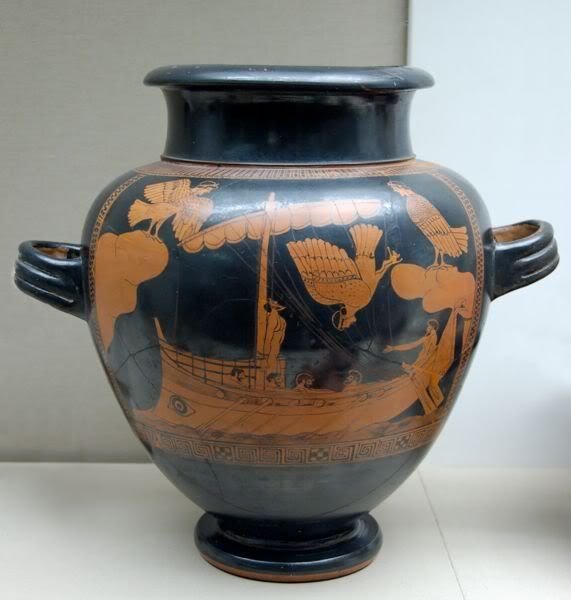
This red Attic vase from the British Museum (ca. 480-470 BC) is thought to have inspired John William Waterhouse's painting of Ulysses and the Sirens. There are a few differences, for example Waterhouse shows 6 Sirens in his painting, whereas this vase appears to only depict 3 (I have not seen the vase myself, so I'm not sure what's shown on the opposite side). But after examining the two pieces a little more closely, I think it's undeniable that Waterhouse used the vase as inspiration for his artwork.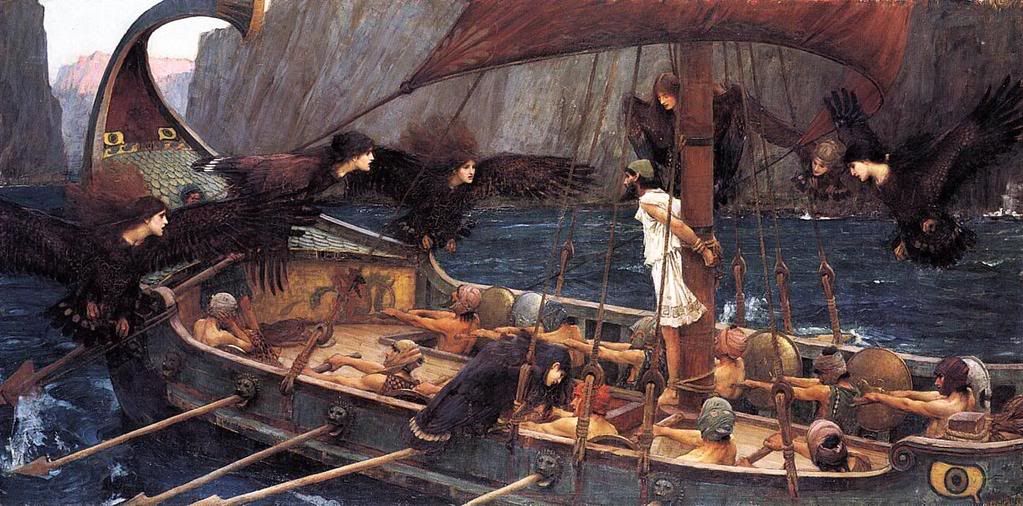
You can tell from this close up that although Waterhouse has chosen to update the Sirens' hairstyles, he has copied their body shape directly from the vase. Likewise the form of the boat and the oars certainly evokes the style depicted on this piece of pottery. You'll also notice that they eyes that decorate the boat are common to both renditions.
images courtesy wikimedia commons.
Posted by
Margaret
at
5:15 AM
6
comments
![]()
![]()
Labels: mythology, waterhouse
Tuesday, June 24, 2008
John William Waterhouse takes on Ulysses and the Sirens
Yesterday I noted that The Times was quite critical of Herbert James Draper's 1909interpretation of Homer's Sirens. Perhaps that is because 18 years before his painting was exhibited, John William Waterhouse had shown his own pictorial representation of Ulysses and the Sirens.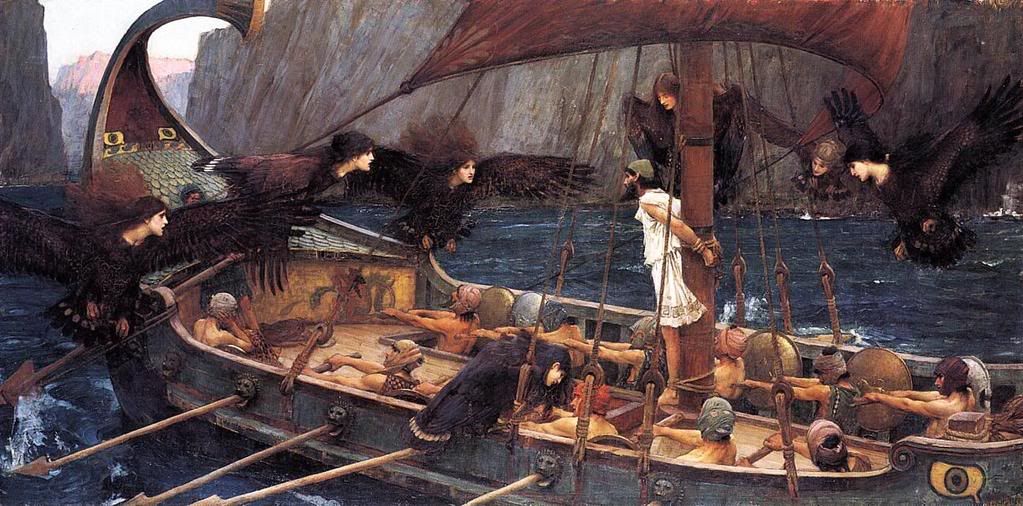
Unlike Draper, who leaned rather heavily on artistic license, Waterhouse was extremely careful to include specific details from the story that only would have been apparent to someone with more intimate knowledge of history. For example, as Australia's National Gallery has pointed out, the faces of Homer and his men, their clothing and helmets, and the boat's design have all been inspired by genuine artifacts.
Furthermore, you'll recall that critics were outraged that Draper portrayed the Sirens as mermaids. But when Waterhouse's rendition of the scene was exhibited 18 years before, critics noted that Waterhouse was one of the first artists to portray the Sirens as bird-like figures, something he might have noticed on a trip to the British Museum, which houses an ancient Greek red figure vase depicting the Sirens as birds.
I appreciate Waterhouse's version because it transports the viewer into the story of Ulysses and has a very clear narrative quality. Draper's portrayal seems to be telling a different tale altogether, but it's so lovely that I can hardly fault it. Both are lovely.
Posted by
Margaret
at
5:13 AM
4
comments
![]()
![]()
Labels: mythology, waterhouse
Monday, June 23, 2008
Herbert James Draper Ulysses and the Sirens
Herbert James Draper (1864-1920) was born in London and studied at St. John's Wood Art School prior to entering the Royal Academy Schools in 1884. Draper showed talent early on and received a gold medal and a scholarship that helped him to travel to Rome and to study at Academie Julian in Paris.
Draper showed his works at the Royal Academy from 1897 until his death, although he was never a member of the Academy (or even an associate). Most of his paintings dealt with subjects from English poetry, particularly anything having to do with the sea.
This painting, Ulysses and the Sirens, was exhibited at the Academy in 1909. But while it was given a central place, the work was strongly criticised. The Times took a particularly dim view of the work, arguing that "Homer's sirens had nothing to do with the conventional mermaid, and did not cling to the ship; they were beings of an undescribed form who sat in a meadow and sang. Really painters ought not thus to amend the text of their authorities." It seems odd today that an artist would receive such harsh criticism for wandering from his source material, but this was a serious consideration in the Victorian art world. I'm afraid they had little patience with artistic liberties!
I love the exceptional beauty of the figures in Draper's paintings, which reminds me a great deal of some of Waterhouse's other works. Draper does an excellent job of capturing the irresistible sensuality of the sirens, whereas Waterhouse's painting of Ulysses and the Sirens seems to focus more on their magical qualities.
According to Homer's tale, three sirens were rumoured to live on an island close to Cape Pelorus in Sicily. The ladies were said to be able to lure sailors to their deaths with their beautiful voices. Having been forewarned by Circe about the sirens, Ulysses filled his crewmen's ears with wax in order to keep them from jumping overboard. However, if the sirens had been as lovely as the sea maidens in Draper's version, I'm not entirely sure that merely being deaf to their songs would have helped very much!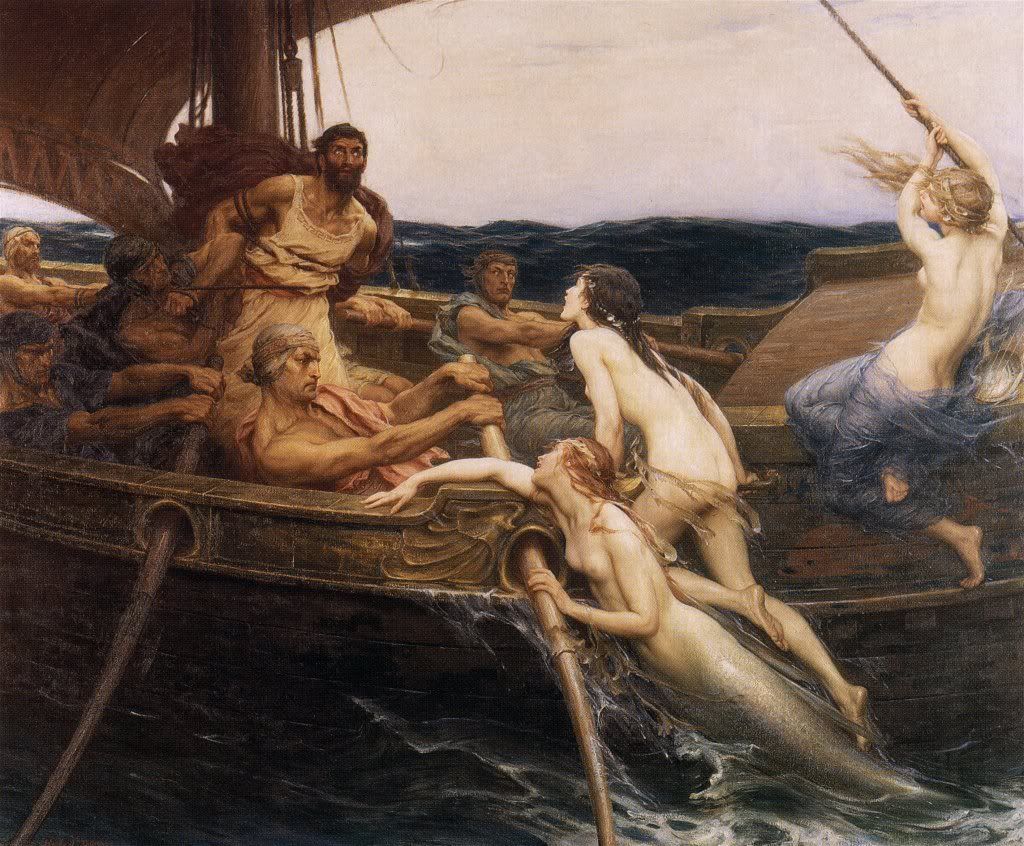
This post owes much of its biographical info to an excellent article on Draper that is included in The Last Romantics (page 127).
image courtesy of wikimedia commons.
Posted by
Margaret
at
5:33 AM
3
comments
![]()
![]()
Labels: mythology
Tuesday, March 25, 2008
Pre-Raphaelite Visions of Penelope
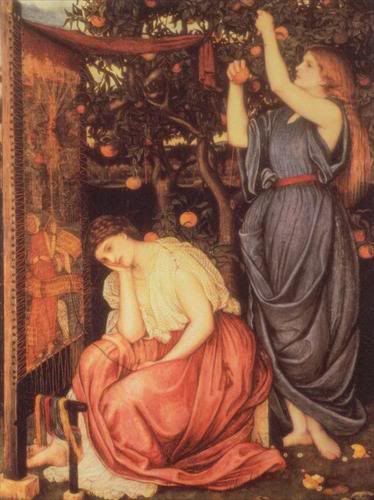
JR Spencer Stanhope was a follower of Pre-Raphaelite Painter Edward Burne Jones. I love his paintings, though critics have often noted that he was not as subtle an artist as Burne Jones. He is noted for his bold use of colour, which unfortunately doesn't come across in this copy of his painting Penelope, which he finished in 1864. The Pre-Raphaelites were a rather close knit circle, as you may have noticed, and Stanhope was actually Evelyn de Morgan's uncle!
Stanhope's Penelope is one of those paintings that has a real way of capturing the emotions of characters in a classic tale. As you will recall, Penelope was the wife of Odysseus in Homer's Odyssey, who waited patiently for him throughout his long travels. She is often associated with the virtue of faithfulness, since she remained dedicated to her husband in spite of the hoards of suitors that dogged her in his absence.
Penelope waited 20 long years for Odysseus to return from fighting the Trojan War. Stanhope's painting portrays Penelope weaving Odysseus' burial shroud (which you will notice is nearly complete--Peneope had promised her suitors that she would remarry once it was complete--but she tricked them by removing some of the stitches every night).
After Penelope's trickery is revealed, she meets an old beggar (Odysseus in disguise, of course). After a long talk with him, she concludes that she will only marry the man who can re-string Odysseus' bow and use it to shoot an arrow through 12 ax handles. After a series of dismal failures on the part of her suitors, Odysseus of course succeeds in a triumph somewhat reminiscent of Arthur's feat of removing the sword from the stone. He reveals himself to be her long lost husband, and after a final identity test, they are reunited.
This painting seems to capture Penelope's sadness quite well! The painting emphasises her emotions, whereas JW Waterhouse's portrays her dedication to her craft. In my opinion his painting is somewhat more artful than it is thoughtful. I love both paintings, but in this case, I think Stanhope's Penelope is my favourite.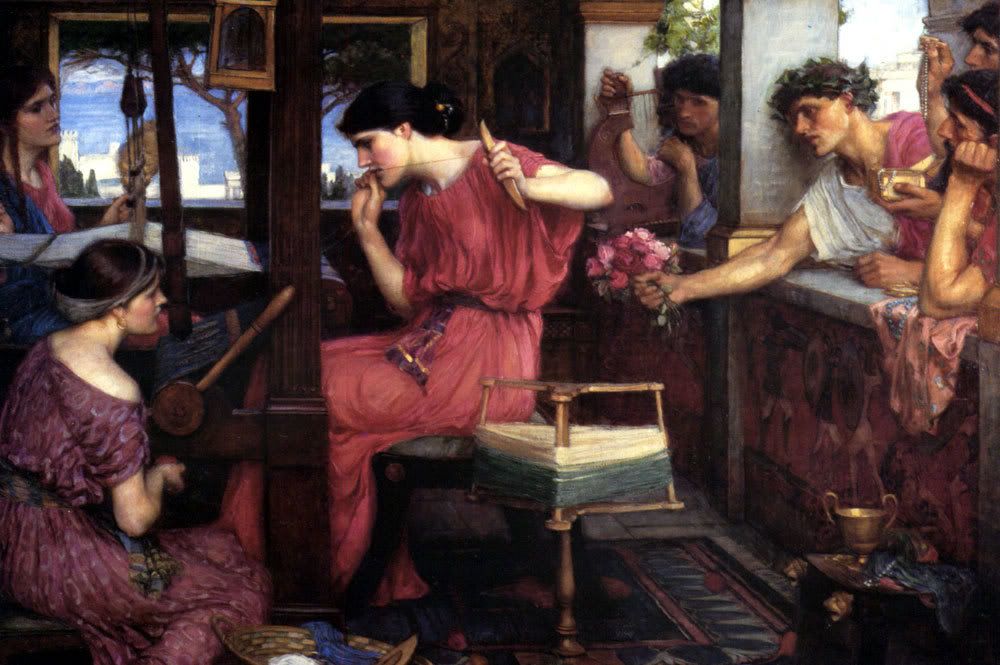
Posted by
Margaret
at
11:40 AM
3
comments
![]()
![]()
Labels: edward burne-jones, mythology, pre-raphaelites, waterhouse

